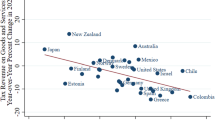Abstract
Worldwide fiscal experience over the past twenty-five years indicates steady expansion in the political and academic constituency for expenditure taxation, including indirect taxes on consumption. Retail levies have emerged as the preferred method of indirect taxation of consumption, as older, pre-retail sales taxes have proven unsuited to modern economic structures. Increasingly, reform of sales taxation has involved a shift to one particular form of tax, the European Community type of value-added tax (VAT). This consumption tax option is again a topic of policy debate in North America, particularly in Canada where a VAT was under active consideration in 1985.
This paper sifts through worldwide experience with broad-based sales taxes to identify lessons for tax policy in North America both in the short and longer-run. It indicates that the reputation of such taxes as regressive instruments may have been much exaggerated, and that in any case methods are available, particularly in Canada, for resolving equity issues in sales taxation. The VAT is shown to have marginal economic and administrative advantages over single-stage federal retail taxes in both Canada and the US. However, these advantages are not nearly so significant as in European countries where the VAT was adopted there. Further, sensible debate over the merits and limitations of the VAT in North America will call for much closer scrutiny of the problems unique to this form of tax. Finally, three political issues that were not significant in Europe will likely have an important bearing on any future choices of sales tax instruments, both in the U.S. and in Canada.
Similar content being viewed by others
References
Ballard, C., J. Shoven and H. Whalley (1985). “General equilibrium computations of marginal welfare costs of taxes in the U.S.,”American Economic Review, 75.
Break, George F. (1964). “Avenues to tax reform: perils and possibilities,National Tax Journal, 37: 2.
Browning, Edgar (1978). “The burden of taxation.”Journal of Political Economy, 86.
Browning, Edgar (1985). “Tax incidence, indirect taxes and transfers.”National Tax Journal, 38: 525–534.
Cnossen, Sijbren (1975). “What kind of sales tax.”Canadian Tax Journal, 23: 514.
Davies, David G. (1961). “Commodity taxation and equity.”Journal of Finance, 16: 581–590.
Davies, David G. (1980). “Measurement of tax progressivity: comment.”American Economic Review, 70: 204–208.
de Toqueville, Alexis, (1840).Democracy in America, Part the second (Translator Henry Reeve, Esq.). London: Saunders Outlay, Conduit St.
Due, John (1957).Sales Taxation. Urbana, Illinois: University of Illinois Press.
Due, John (1985). “Accepted vs conventional sales tax structures.”Australian Tax Forum, pp. 366–368.
Due, John and John L. Mikesell (1983).Sales Taxation. Baltimore: Johns Hopkins Press.
Gratz, Michael J. and Louis L. Wilde (1985). “The economics of tax compliance: fact and fantasy.”National Tax Journal, 38: 355–364.
Gillis, Malcolm, (1985). “Federal sales taxation: a survey of six decades of experience, critiques and reform proposals.”Canadian Tax Journal, 33.
Gillis, Malcolmet al. (1983).Economics of Development. New York: Norton.
Gillis, Malcolm (1986, forthcoming). “Financial and housing services and the value-added tax.” Canadian Tax Foundation,Report of Proceedings of the 36th Tax Conference. Toronto: Canadian Tax Foundation.
Government of Canada (1983).Report of the Federal Sales Tax Review Committee. Ottawa. (The Goodman Report).
Hettich, Walter and Stanley Winer (1985). “Blueprints and pathways: the shifting foundations of tax reform.”National Tax Journal, 38: 423–446.
Institute for Fiscal Studies (1978).The Structure and Reform of Direct Taxation. Report of the Meade Committee. London: Allen and Unwin.
Lodin, Sven-Olof (1976).Progressiv Utgiftsskatt — eet alternativ. Stockholm: Statens Offentliga Utredningar. The report of the 1972 Government Commission on Taxation.
Matthews Committee (1975).Report of the Committee of Inquiry into Inflation and Taxation. Canberra: Australian Government Printing Service.
Mayer, Thomas (1974). “The distribution of the tax burden and permanent income.”National Tax Journal, 27: 141–146.
Norr, Martin and Nils G. Hornhammer (1970). “The value-added tax in Sweden.”Columbia Law Review, 70: 379–422.
Office of the Advisory Panel on Goods and Service Tax (1985).Second Report of the Advisory Panel on Goods and Service Tax to the Minister of Finance. Wellington, New Zealand.
Organization for Economic Cooperation and Development, Committee on Fiscal Affairs (1981).The Impact of Consumption Taxes at Different Income Levels, Paris: OECD.
Slemrod, Joel and Nikki Sorum (1984). “The Compliance Cost of the U.S. Tax System.”National Tax Journal, 37: 461–473.
Shoup, Carl (1969).Public Finance. Chicago: Aldine.
Stockfish, J.A. (1985). “Value-added taxes and the size of government: some evidence.”National Tax Journal, 38: 549.
Tait, Alan M. (1985). “The value-added tax: why and how.”1984 Conference Report: Report of Proceedings of the Thirty-Sixth Conference. Toronto: Canadian Tax Foundation.
U.S. Dept. of Treasury (1977).Blueprints for Basic Tax Reform. Washington: U.S. Government Printing Office.
U.S. Dept. of Treasury, Office of the Secretary, (1984).Tax Reform for Fairness, Simplicity and Economic Growth. Washington: U.S. Treasury Department, Vol. 1 and Vol. 3.
Author information
Authors and Affiliations
Rights and permissions
About this article
Cite this article
Gillis, M. Worldwide experience in sales taxation: Lessons for North America. Policy Sci 19, 125–142 (1986). https://doi.org/10.1007/BF02113492
Issue Date:
DOI: https://doi.org/10.1007/BF02113492




